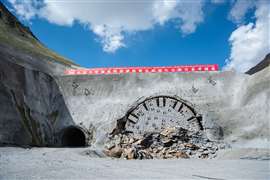Economic Outlook: China
12 April 2011

China is a special case as construction markets go. Technically it did not experience a recession - in fact the construction sector boomed due to an aggressive stimulus package that targeted residential and infrastructure development. As a result, a big bounce in growth is not to be expected. In fact, as stimulus is withdrawn, the expectation is that growth will slow.
China remains a centrally planned economy, and the Chinese Communist Party has laid down ambitious goals for China's economic transformation in the country's 12th five-year plan which will anchor development from 2011 to 2015. The new plan shifts away from the long-standing growth-at-all-costs mantra, and moves toward a development-oriented strategy that emphasises economic, social and environmental sustainability.
The plan lays out a long list of tasks to be accomplished in the next couple of years, including agricultural and rural development, industrial structure adjustment, regional development, urbanisation, social development, and resource & energy conservation. The Chinese leadership is looking at rural areas and underdeveloped areas for the development of new domestic demand, and looking at institutional reforms to remove various distortions that have been responsible for economic imbalances.
China is conducting a new industrialisation drive that focuses on boosting added value and job creation. That implies the acquisition of key technologies, aggressive development of emerging strategic sectors that could put China in the same league of developed countries in such industries, as well as more efforts for the development of the services industry.
Construction impacts
The rural development aspect of the plan will see an emphasis on strengthening basic rural infrastructure and the public service network, particularly health care. Industrial structure adjustments include the upgrading of the manufacturing sector, developing emerging and strategic industries, speeding up development of the services sector, strengthening the construction of energy and transport infrastructure and enhancing the application of IT in industrial sectors.
As noted by the Chinese premier, China's manufacturing industry is still quite backward even though over half of the 30 manufacturing subsectors are currently the largest in the world. The government is to take different approaches towards different sectors. The focus for the consumer goods industry - such as textiles and light industries - is upgrading. The focus for resource material industry, such as metals and petrochemicals, is readjustment - consolidation, restructuring and elimination of outmoded capacity. For advanced equipment industries - equipment manufacturing, automotive and shipbuilding - there will be continued policy support for drive expansion.
Another main thrust will be the development of new strategic sectors. In a statement issued at the end of October 2010, China's State Council has announced that the country will raise seven emerging and strategic industries' share in national GDP to 8% by 2015, from the current less than 2%.
The share of such industries will be further boosted to 15% by 2020. The seven industries include energy conservation/environmental protection, new-generation information technology, biology, high-end equipment manufacturing, new energy, new materials and new-energy-fuelled vehicles. The first four industries are also to become the "pillar industries" of the country by 2020, while the other three emerging strategic industries will be defined as "leading industries."
Not all regions will be affected equally as priority is given to a western development programme, the development of ethnic regions such as Tibet and Xinjiang, as well as north-east rustbelt and central China.
Developing the services industry will remain a priority as China moves from a resource/energy-intensive and job-light model to one that depends less on resource inputs and yet may create more jobs.
The government will also to promote the formation of service-oriented economic structures in mega-cities, which should include Shanghai, Beijing and other developed areas of coastal China.
The first implication of the plan for construction is that the drive for consumption over investment is likely to create a permanently lower construction growth rate. This is relative, and China will still achieve a construction growth rate of +7% or more for the next decade. However, the era of double digit construction growth is probably over.
The second implication is that while all structure types will see slowing growth, it will not be evenly distributed. The weakest segment will be industrial structures as China focuses on expanding a services oriented economy. There will be some consolidation of "old" industries, but there is potentially strong growth for "new" technologies targeted by the plan such as nuclear and renewable energy, pharmaceuticals and next generation IT applications.
An emphasis on expanding and improving health care for all suggests that institutional structures will outperform other building types within the non-residential structures category. Moreover, as demographics continue to shift to urban areas, this will also expand the scope for government services, including education, health care, and public safety.
While residential construction growth will also slow from its stimulus-induced pace, the intent to continue migration from the hinterland suggests that this segment should still do quite well. Indeed, to the extent that China succeeds in developing its mega-cities, and in expanding incomes and its middle class, the residential sector could fare quite well, not only from new and refurbished units, but also from the higher quality units demanded by an increasingly affluent society.
Infrastructure spending has been, and will remain, the fastest growing segment of the construction industry. Whether it be greater access to the hinterland, development of areas forgotten by the boom, the expansion of its cities, the improvements to water supply or the additions of new and cleaner power generation sources, every element of the new five year plan will require infrastructure expansion.
China's new five year plan does suggest a more moderate construction expansion in the future, but it also suggests one that is sustainable and targeted to the country's needs.






